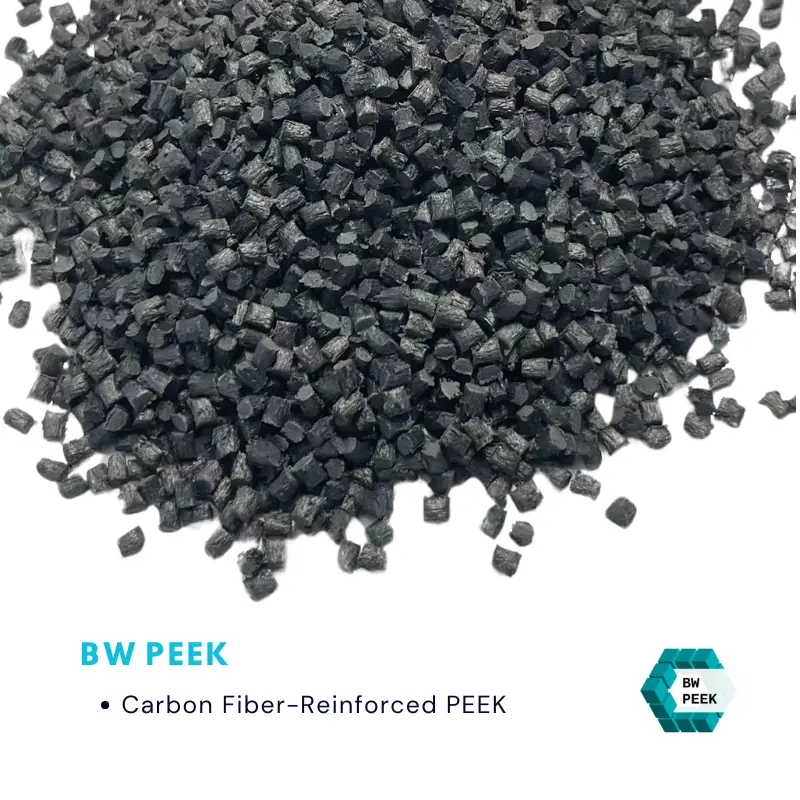
PEEK (polyether ether ketone) is a new type of semi-crystalline aromatic thermoplastic engineering plastics, which was successfully developed by Imperial Chemical (ICI) in the late 1970s. The material possesses high levels of heat, radiation and corrosion resistance, as well as excellent dimensional stability and electrical properties, and outstanding processability, among many other advantages. As a result, PEEK is recognized as one of the world's highest-performance thermoplastic materials and is widely used in the defense and military industries, the aerospace industry, the electronics and information industry, energy development, processing and utilization, automotive manufacturing, home appliance production, and medical and health care."




















| Mechanical Behavior | ||||||
| Item | Test Standard or Instrument | Unit | Nature PEEK | Glass fiber PEEK | Carbon fiber PEEK | Wear-resistant PEEK |
| Tensile strength(23℃) | ISO527 | MPa | 100 | 155 | 220 | 134 |
| Bending strength(23℃) | ISO 178 | MPa | 163 | 212 | 298 | 186 |
| Compressive strength(23℃) | ISO 604 | MPa | 118 | 215 | 240 | 150 |
| Lzod impact strength( no gap) | ISO 180/IU | kJ/m² | No Crack | 51 | 46 | 32 |
| Thermal Performance | ||||||
| Item | Test Standard or Instrument | Unit | Nature PEEK | Glass fiber PEEK | Carbon fiber PEEK | Wear-resistant PEEK |
| Melting point | DSC 11357 | ℃ | 343 | 343 | 343 | 343 |
| Distortion temperature | ISO 75-1/2 | ℃ | 163 | 315 | 315 | 293 |
| Continuous using temperature | UL 74685 | ℃ | 260 | 260 | 260 | 260 |
| Coefficient of thermal expansion | ASTM D696 | 10 -5℃ | 4.7 | 2.2 | 1.5 | 2.2 |
| Flammable level | UL 94 | V-0@mm | 1.5 | 1.5 | 1.5 | 0.75 |
| Electrical Performance | ||||||
| Item | Test Standard or Instrument | Unit | ARKPEEK-1000 | ARKPEEK-GF30 | ARKPEEK-CF30 | ARKPEEK-MOD |
| Dielectric strength | IEC 60243-1 | kV/mm | 18 | 19 | ||
| Dielectric constant | IEC60250 | - | 3.2 | 3.3 | ||
| Surface resistivity | Ω | 10 15 | 10 15 | 3*10 6 | 5*10 6 | |
| Other Performance | ||||||
| Item | Test Standard or Instrument | Unit | Nature PEEK | Glass fiber PEEK | Carbon fiber PEEK | Wear-resistant PEEK |
| Density | ISO 1138 | g/cm3 | 1.3±0.01 | 1.5±0.01 | 1.4±0.01 | 1.43±0.01 |
| Rockwell hardness | ISO 2039 | HRR | 118 | 119 | 121 | 108 |
| Friction coefficient | μ | 0.30-0.38 | 0.38-0.46 | 0.28 | 0.18 | |
| Water Abs. (25℃.24Hrs) | ISO 62 | % | 0.5 | 0.11 | 0.06 | 0.06 |
| Mould shrinking percentage | 3mm,170℃, Flow direction | % | 1.2 | 0.4 | 0.1 | 0.3 |
| Perpendicular to flow direction | % | 1.5 | 0.8 | 0.5 | 0.5 | |